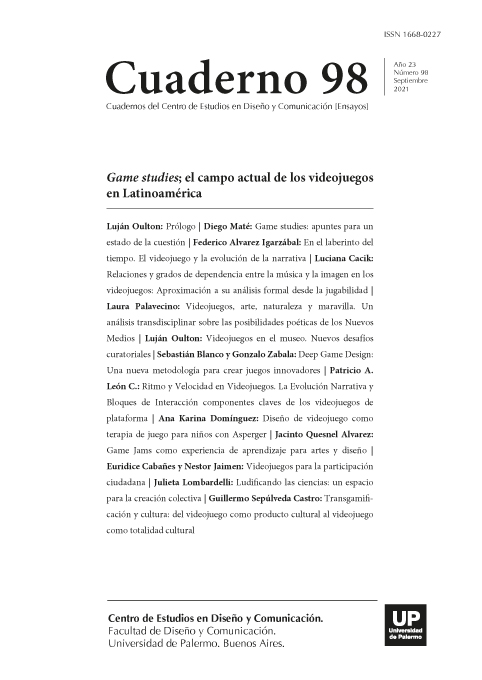Deep Game Design: Una nueva metodología para crear juegos innovadores
Resumen
El presente trabajo consiste en la propuesta de una nueva metodología llamada Diseño Profundo de Juegos cuyo objetivo es sentar las bases para desarrollar videojuegos que expandan los límites del medio. La propuesta parte del estado del arte actual, de las mecánicas experimentales y los procesos de diseño, así como también del enfoque sistémico de los juegos y su significado antropológico. Se expone además un conjunto de videojuegos cuyo desarrollo fue observado y utilizado como base para la realización de la presente metodología.
Citas
LLC. (2013). Papers, please. Aleem, S., Capretz, L., &
Ahmed, F. (2016). Game Development Software Engineering Process Life Cycle: A Systematic Review. Journal of Software Engineering Research and Development. App Figures. (Octubre de 2018). Obtenido de https://www.statista.com/statistics/780229/number-of-available-gaming-apps-in-the-google-play-store-quarter/
Bahrami, M. (2017). Engare. Benmergui, D. (s.f.). Storyteller.
Blow, J. (2014). Attempting Deep Work - How to survive long projects. Obtenido de: https://www.youtube.com/watch?v=d0m0jIzJfiQ
Bosch, M. t. (s.f.). Miegakure. Campbell, J. (2008). The Hero with a Thousand Faces (The Collected Works of Joseph Campbell).
Csikszentmihalyi, M. (1998). Finding Flow : The Psychology Of Engagement With Everyday Life. Nueva York: Ingram Publisher Services US.
Deepmind Technologies. (2016). Mastering the game of Go with deep neural networks and tree search. Nature.
Enriz, N. (2011). Antropología y juego: apuntes para la reflexión. Cuaderno de antropología social nº 34. Google. (s.f.). Experiments with Google. Obtenido de https://experiments.withgoogle.com/collection/ai
Hecker, C. (2018). Spy Party. Hella Velvet. (s.f.). Voiceball Presskit. Obtenido de http://hellavelvet.com/press/voiceball/
Huizinga, J. (1970). Homo Ludens: A study of the play element in culture. Londres: Maurice Temple Smith Ltd.
Hunicke, R., Leblanc, M., & Zubek, R. (2004). MDA : A Formal Approach to Game Design and Game Research. Increpare Games. (2016). Stephen's Sausage Roll.
Kanode, C., & Haddad, H. (2009). Software Engineering Challenges in Game Development. Proceedings of the 2009 Sixth International Conference on Information Technology: New Generations. IEEE Computer Society.
Kim, W. C., & Mauborgne, R. (2005). Blue Ocean Strategy. Harvard University Press.
Kuchera, B. (10 de Enero de 2018). Polygon. Obtenido de https://www.polygon.com/2018/1/10/16873446/steam-release-dates-2017
Le Blanc, M. (s.f.). 8KindsOfFun. Obtenido de http://algorithmancy.8kindsoffun.com/
ModDB. (s.f.). Obtenido de https://www.moddb.com
Mojang. (2011). Minecraft. Nintendo EPD. (2018). Nintendo LABO.
Number None Inc. (2008). Braid. Pressman, R., & Maxim, B. (2015). Software engineering: A practitioner's approach. New York: McGraw-Hill Higher Education.
Roberts, J. (14 de 12 de 2017). The Puzzle Of A Lifetime. (C. Kohler, Entrevistador)
Roberts, J. (2018). GDC Vault. Obtenido de https://www.gdcvault.com/play/1024960/-Gorogoa-The-Design-of
Schell, J. (2008). The art of game design : a book of lenses. Amsterdam ; Boston: Elsevier/ Morgan Kaufmann.
Teikari, A. (2019). Baba is you.
Thatgamecompany. (2012). Journey.
Thekla Inc. (2016). The Witness. Upton, B. (2015). The Aesthetics of Play. MIT Press.
Valve Corporation. (2007). Portal.
Los autores/as que publiquen en esta revista ceden los derechos de autor y de publicación a "Cuadernos del Centro de Estudios de Diseño y Comunicación", Aceptando el registro de su trabajo bajo una licencia de atribución de Creative Commons, que permite a terceros utilizar lo publicado siempre que de el crédito pertinente a los autores y a esta revista.


